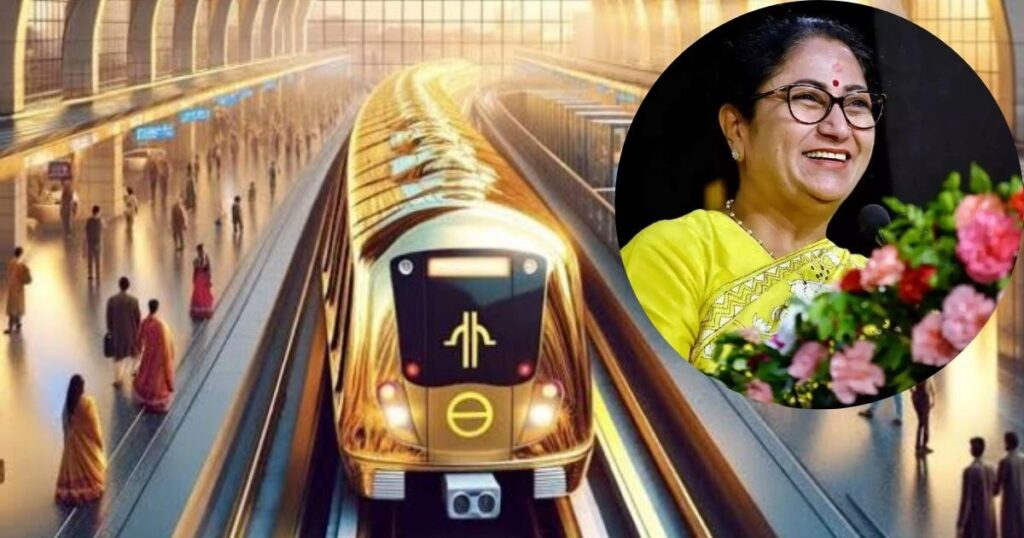CM Gupta Announces New Names: Pitampura becomes Madhuban Chowk, new North Pitampura station honours Prashant Vihar.
Delhi Chief Minister Rekha Gupta’s recent announcement to rename three prominent metro stations has ignited a sharp debate across the national capital, with critics questioning the administration’s immediate priorities amidst severe, long-standing challenges in public education, infrastructure, and the recurring air pollution crisis.
The controversy centers on the Sunday announcement made by CM Gupta via a post on X (formerly Twitter). The key changes involve the existing Pitampura Metro Station being renamed Madhuban Chowk Metro Station. Additionally, the proposed North Pitampura station will now be known as North Pitampura-Prashant Vihar Metro Station, and the proposed Pitampura North Metro Station will be designated the Haiderpur Village Metro Station.
The Chief Minister’s Stated Motive: Clarity and Local Identity
In defending her decision, CM Gupta outlined two primary motives that she asserts make the renaming essential for the city’s development and civic convenience:
Passenger Convenience and Clarity: The Chief Minister emphasized that the new names are a practical measure intended to enhance commuter experience. By correlating the station names more accurately with the specific neighbourhoods they serve—such as Madhuban Chowk, Haiderpur Village, and Prashant Vihar—the changes will help passengers quickly and confidently identify where they need to get off, reducing confusion and improving the functionality of the metro system.
Strengthening Local Identity: Beyond mere practicality, Gupta framed the move as a nod to local sentiment. She stressed that the renaming acknowledges long-standing local demands and strengthens the cultural and geographical connection between the stations and the communities that use them. This motive was symbolically reinforced by timing the announcement with the arrival of the sacred Raj Kalash Yatra at Haiderpur. This Yatra honours the brave martyrs of the Rezang La War, allowing the renaming of the ‘Haiderpur Village Metro Station’ to be linked to a moment of significant national and regional pride.
CM Gupta’s official statement underscored this dual purpose: “For the convenience of passengers and to clearly define the local identity… Our government is fully committed to the comprehensive development of this area.”
Public Reaction: A Question of Priorities
Despite the CM’s assurances of improved convenience, the public response has been distinctly divided. While some local residents welcome the recognition of their neighbourhoods on the official metro map, a significant portion of the public and opposition parties have expressed sharp criticism over the administration’s perceived misallocation of focus and resources.
The core of the criticism revolves around the idea that the government is focusing on cosmetic changes—renaming existing infrastructure—rather than tackling profound, urgent, and life-threatening issues:
Focus on Core Issues (Air Pollution): Critics argue that the government should allocate its attention and resources to more pressing, city-wide crises that directly impact public health and quality of life. Chief among these is the recurring, annual issue of severe air pollution, which plunges Delhi into a public health emergency every winter, often forcing school closures and imposing stringent GRAP restrictions. While the CM has recently been involved in reviewing anti-pollution measures, the high-profile metro renaming announcement has effectively overshadowed these efforts, leading to accusations of distraction.
Infrastructure and Education: Demands persist for large-scale, tangible improvements in Delhi’s core public services. This includes overhauling the public education system to meet modern standards and addressing crumbling civic infrastructure, such as repairing heavily damaged roads and undertaking serious efforts to clean the heavily polluted Yamuna river. Opponents contend that spending political capital and administrative energy on a relatively minor cosmetic change to metro signs is an insufficient substitute for tackling these deep-seated governance challenges that require massive investment and sustained focus.
The renaming exercise, though officially framed as enhancing infrastructure utility and celebrating local identity, has inadvertently opened a wider political discussion on the effective utilization of government resources and the administration’s actual focus in a capital city grappling with profound developmental and environmental emergencies. The debate remains: does this change truly reflect a commitment to comprehensive development, or is it a calculated move to capture local sentiment while diverting attention from systemic failures?






